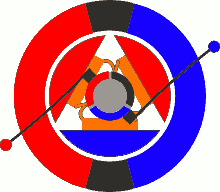I understand the field magnets attracting/repelling the armature/coil so that it turns one half-turn and then, because the commutator is turned, its contact with the brushes has switched sides, and the current goes in the opposite direction, reversing the electromagnetic polarity. Then, because the polarity is swapped, it attracts/repels to complete the second half-turn. The thing is, isn't it a bit of a gamble that it will turn in the same direction? Couldn't the it just be pulled/pushed back, more or less undoing the half-turn?
I'm also a bit confused how the rotation doesn't just stop once the commutator is oriented so that the brushes are contacting both sides of the commutator. In other words, there's a brief period just as the commutator switches the current directions where each both the brushes are in contact with both sides of the commutator where the current is neutralized. Shouldn't this stop the motor?

For reference, I'm just talking about a simple DC motor.


